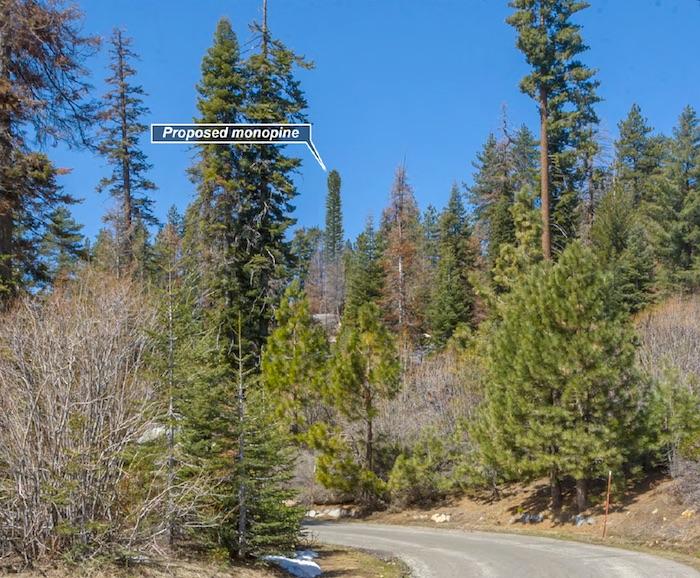
Verizon Wireless wants to disguise a cellphone tower as a pine tree at Sequoia National Park. The perspective of this shot makes it difficult to determine how high above the rest of the forest the tower would rise/NPS, Verizon Wireless
If a scrawny looking pine tree towered above other pines near Wuksachi Lodge in Sequoia National Park, would you figure out that it was a cellphone tower? And would you then care that your backcountry hikes might be interrupted by someone chatting loudly on their phone or streaming Drake?
Those are questions the National Park Service is seeking your thoughts on as they consider a proposal from Verizon Wireless to disguise a cellphone tower as a pine tree near the lodge.
The ubiquitous nature of cellphones these days brings more and more demands for cell signals wherever one roams, even if they might be in a forest of giant sequoias. That said, just 29 people took time to comment on the proposal earlier this year, though 17 of those expressed concerns that widespread cellphone coverage "reduces the contrast between wilderness and other lands, and negatively impacts wilderness character."
Against that position, though, are the views of employees in the park who feel isolated without cellphone coverage, and the safety aspect of being able to quickly contact help.
A total of 203 health and safety incidences were recorded in the Lodgepole / Wuksachi area in 2017, including search and rescue calls (20), emergency service calls (146), motor vehicle collisions (33), and fatalities (4). -- National Park Service
Verizon Wireless is proposing to construct a 138-foot cellular tower west of Wuksachi Village to achieve a coverage objective that includes a portion of the Generals Highway, the Wuksachi Village, Lodgepole, and Wolverton areas. Antennas would be directed, as much as possible, away from the wilderness, the park's environmental assessment says.
Comments on the plan are being taken through November 26.
The proposed wireless communications facility would include the following components within a 40-foot by 40-foot area adjacent to two existing above-ground water storage tanks:
- A 138-foot tall tower with panel antennas and microwave dishes, potentially constructed to simulate a pine tree, mounted on a 4 to 5-foot diameter footer
- A covered 28-foot by 13-foot steel equipment platform
- A 500-gallon propane tank mounted on a concrete pad
An estimated 1,420 feet of buried electrical cable would be installed along the existing access road to connect the tower to an existing electrical transformer. Two 14-inch diameter fir trees would be removed from the facility site. A total of approximately 0.23 acres of land within the park would be affected by the project, including the trenched area adjacent to the access road (0.19 acres), and the communications facility (0.04 acres).



Comments
Can a cell tower be fixed to only receive 911 transmissions? Just curious....
Theoretically yes. A phone without paid service can still make emergency calls. However, Verizon wouldn't have an incentive to install a tower like this without regular service available. In addition, this would be for use of NPS and concessionaire staff.
It's not in a Wilderness.
i visited Sequoia this spring. I see both sides of the issue. Can this be done with no harm to the trees? I'm not familiar with the specific area, but digging could impact roots. I've seen a number of disguused cell towers, they fool no one who pays attention.
Sorry all. I missed the datum that my summer was in a wilderness park, so my comments on this tower in particular were not specifically on the nose, but if you throw out that particular item the gist still applied.
Read y-p-w post, sums it up well.
While the placement of a cell tower has to legally respect wilderness designations, the signals do not. I realized that there was cell service when I was woken up by a boy scout in a nearby tent talking to his mom on his cell phone in Yosemite. It's a tool that I'd hope people could use responsibly. If there's an emergency, I'd think most people with one could use it more effectively than a radio for calling in emergencies.
Sometimes I don't really understand the furor over installing cell towers, as if perhaps people are living/working in museums where technological progress has ended. The one thing I really didn't get was that the management at Yellowstone NP protested against a cell tower in Gardiner.
Note: I edited this (to clean up the quote) so it might be out of order compared to when I initially posted it.
I was at an overlook in Grand Teton while a family had a speakerphone conference call about when to meet up later, with no regard to its impact on others. I do not think individuals are able to police themselves and their impact. I think cell towers are simply the first step towards making parks just like everywhere else.